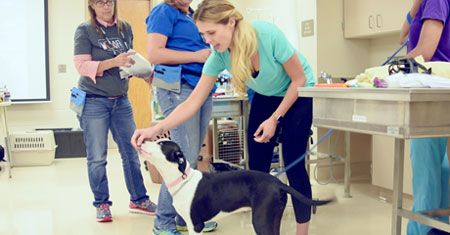Food vs. needle: Food wins
Mikkel Becker shows CVC attendees how to treat to distract for blood draws. (Photo: Ryan Kramer)Nobody likes a needle, not even dogs.

Mikkel Becker shows CVC attendees how to treat to distract for blood draws. (Photo: Ryan Kramer)Nobody likes a needle, not even dogs. And many of you have probably, successfully or unsuccessfully, offered treats during a physical exam, injection or blood draw. Here's one Fear Free [HYPERLINK TO CERTIFICATION???] advocate and CVC educator's take on the quick-and-tasty way to distract a patient and reward them for a job well done.
"We want to turn that positioning into a positive," says Mikkel Becker, CBCC-KA, CPDT-KA, CDBC, CTC, KPA Graduate, in this video from a CVC hands-on learning session.
Interested in more Fear Free content?
> Learn about getting certified as a Fear Free practitioner here.
> Join us at CVC Virginia Beach, Kansas City or San Diego in 2017 for "Less-Stress and Fear Free Patient-Caregiver Instructions."
> Also at each CVC this year, take part in a full day of sessions on the "Fear Free Practice" track.
Her technique?
> Get the dog right in front of your legs, in a place where you can position the dog forward and away from the blood draw.
> Get an assistant to treat fast and continuously for maximum positive reward and distraction.
In the video below, Becker stands behind the dog to position and hold the head forward, and second and third assistants give the treats and help the dog remain seated. You can see it doesn't last long!